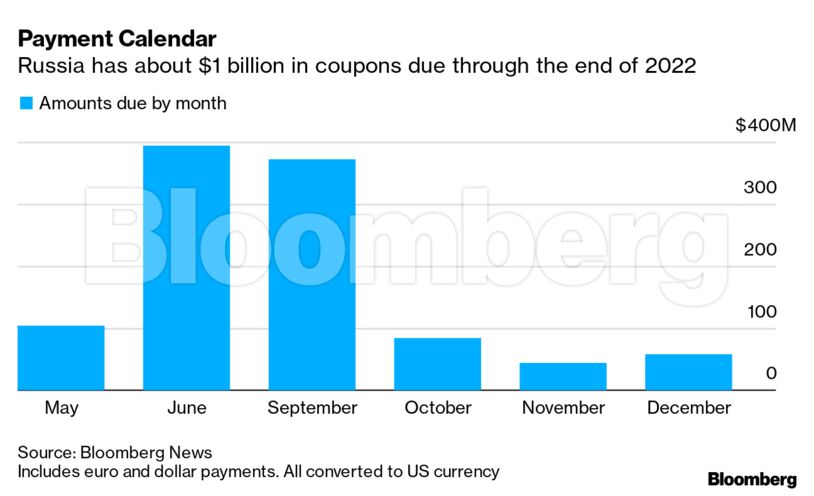It’s the latest twist in a debt saga that has dragged on for months as the war in Ukraine and sanctions complicate the flow of cash from Russia to creditors. If Russia’s obligations aren’t fulfilled, a 30-day grace period ensues.
“We are in uncharted waters,” said Ehsan Khoman, head of emerging market research at MUFG Bank Ltd. in Dubai. “All eyes are now on May 27.”

Russia’s financial chiefs have scrambled to get the payments through so far, but it’s only a matter of time before Russia slides into its first external bond default since the aftermath of the 1917 revolution.
While a default would formally seal Russia’s financial isolation since the invasion of Ukraine, the around $20 billion it owes to foreign eurobond investors pales in comparison with the czarist-era debt, equivalent to hundreds of billions of dollars, repudiated by the Bolsheviks.
Funds Available
The nation still wants to protect its reputation as a reliable borrower, a point reiterated by Finance Minister Anton Siluanov in a lecture at Finance University in Moscow. He told students on Friday that Russia has the funds and the willingness to pay.
“Western countries are defaulting on themselves,” he said. “This is nonsense.”
By Friday, investors are supposed to receive $71.25 million in interest on debt maturing in 2026 and 26.5 million euros ($28.5 million) on bonds maturing in 2036. Russia said last week it met its obligations by transferring the money to the National Settlement Depository, the main central securities depository in Moscow.
The contractual terms of the notes state that NSD is the registered holder of the bonds for the purpose of making principal or interest payments, which could support Russia’s argument even if the funds aren’t sent to individual investor accounts. That could allow the country to avoid a default situation tied to these payments.
Temporary Exemption
The transfer to NSD came just days before a temporary exemption for US bondholders to receive Russian bond payments expired. Without the carve-out, US individuals are barred from accepting debt payments from Russia’s government.
If a payment isn’t completed, Russia then has a grace period of up to 30 days to find a solution, such as it did in early May, when it got money to investors at the very end of that extension after payments were initially blocked.
Russia’s finance minister said on Thursday there are plans to offer a new tool for bondholders that would allow them to receive principal and interest on Russia’s foreign debt. He’s also said it would make payments in rubles.
Risk Remains
As Russia pushes to avoid default and get sanctions lifted, it’s using global concerns over food shortages as leverage. On Thursday, the US rejected Russia’s proposals to facilitate Ukraine’s grain and fertilizer exports in exchange for a removal of restrictions.
Swaps are pricing in an 87% chance of a Russian sovereign default within a year, according to ICE data services.
Some focus has also shifted to the outcome of a review by the Credit Derivatives Determinations Committee, a panel of dealers and investors that is assessing whether a default may have already occurred when Russia failed to include $1.9 million in extra interest on a payment made earlier this month.
“Typically, default on sovereign debt is related to the government’s inability to pay due to a lack of available funds,” said Darshak Dholakia, a partner at Dechert LLP. “Here, Russia is able and willing to make payments, but nevertheless could be declared to be in default due to an inability of bondholders to accept payments and of banks to process payments.”

















 Become an Insider
Become an Insider
Comments - Please login in order to comment.